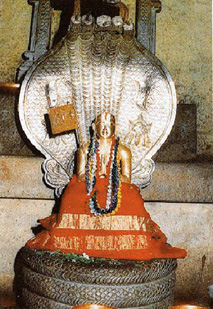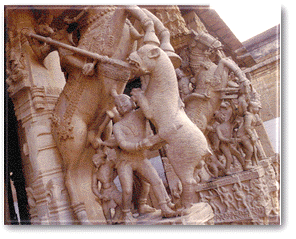NAMO NARAYANA
 |
|
-

- sri:
srimate ramanjuaya namah:
- sriranga nayika sametha sri rangantha
prabrahmane namah:

-
- AcharyaThaniyan on
Sri Manavala Mamunigal
- ( based on the Bhakti Group
Postings dated Nov 5th & 9th 1999 )
|
- by
- Sri U.Ve Velukkudi Krishnan Swami
-

-
- An Image of Sri Manavala Mamunigal
at Thiruvahindrapuram
-
- SrisailEsa dayApatram dhIbhaktyAdi
gunArnavam
yatIndra pravanam vandE ramyajAmAtaram munim.
-
- It is known to one and all that the above srisukti was submitted
to the feet of Swami MM by none other than Lord Ranganatha. Namperumal
wanted to hear tiruvoimozhi kalakshepam from Swamy MM. He conducted
kalakshepam of tiruvoimozhi starting on the paritapi year 31st
day of avani sukla caturdasi friday. It continued for 1 year
and the sattumurai was on aani moolam. For this one year all
the utsavams of namperumal were stopped. During the sattumurai,
namperumal appeared as a 5 year old archaka boy and recited this
sloka in praise of his acharyan i.e. MM. Why did he choose MM
as his acharyan.
-
-
- Here is an interesting logic.During Ramavatara Viswamitra
was Rama's guru who teached mantras. But was he the right guru
for such a great being like Rama ? No. He himself was a person
who fell prey to kama and krodha. We know that he became the
father
of Sakuntala and in another instance he even forgot his nitya
anushthana. So Rama was not fortunate enough to get a right guru
who would be apt for his prabhavam. Rama waited till the next
avatara.
-
- Saandipana was Krishna's guru. When the vidyabhyasa was over
, Krishna wanted to give guru dakshina anything that his guru
wanted. Initially, saandipana refused to accept anything. When
Krishna insisted, he consulted his wife and kept a request to
Krishna. To search and bring back his lost son. (odu vaimayumuvaniyarpirappum
unakku mun tanda anthanan oruvan - kaadal en magan pugalidam
kanen - kandu nee taruvai - kodil vaymayinan). Krishna even though
fulfilled the wish of his guru, was sad. Why ? Would it not be
fitting for a guru to request Krishna for moksham and kainkarya.
Leaving that he requested for a wordly pleasure - son. So, krishna
had to again wait till his next avatara.
-
- Lord Ranganatha is the representative of Rama and Krishna.
Thondaradippodi alwar in his tirumalai first says " silayinal
ilangai setra devane devanavan" then adds " kattrinam
meytha endai kazhalinai panimineere".When we said to alwar
that both are not possible because Rama and Krishna belong to
a different yuga and we are in Kali yuga , alwar gives the solution
" kaattinan tiruvarangam uypavarkku uyyum vannam".
So Ranganatha is undoubtedly the representative of Rama and Krishna.Ranganatha
decided not to miss the bus atleast in this avatara - i.e. to
have a guru commensurate with his own mahima.

- Thousand Pillared Mantapam at
Srirangam
-
- Thus, he selected MM as his guru. This is evident from the
taniyaan that Ranganatha has submitted to the lotus feet of Swami
MM. Srimannarayana is the prathamacharya in our sampradaya. MM
is the acharya for the prathamacharya. Everyone prostrates before
the Lord and say Namaha or vande.
-
- The Lord himself is uttering "vande" towards MM
here. Such is the greatness of MM in our sampradaya.Both the
acharya and sishya stand out for their beauty (handsome). Sisya
is azhagiya manavalan. Acharya is azhagiya manavala muni.Srisailesa
dayapatram is praised as the mantra, stotram and pranamam recited
of Ranganatha. I will write as to how it is a mantra ( as told
by our poorvacharyas) and how it is held in high esteem than
tirumantram.
-
- The word mantra means :
-
- 1. " mantAram trAyata iti mantra: " - 'that which
protects one who chants or thinks about it.' i.e. we keep tirumandiram
in our nitya anusandhanam and it protects us. Even the Lord himself
is called as Mantra: . Tirumangai alwar in his tirunedunthandakam
: "andanar mattu andi vaitha mandirathai mandirathal maravadu
enrum vazhdiyel vazhalam mada nenjame." andanar - brahmin,
madu - wealth (vedas are the wealth of brahmins-brahmanAnAm dhanam
veda:) andi - vedantam. andi vaitha mandiram - bhagavan. mandirathal
-
tirumandirathal vazhthavendum. In this song both bhagavan and
tirumandiram are called as mantram by alwar - as both of them
protect anyone who thinks about them. In sahasranama also we
come across "mantra: candrAmsu: bhaskaradyuti:"
-
- 2. Mantra also means "matri guptabhashaNe" - that
which is a rahashya. Of course we know, tirumandiram is the first
of the rahasya.Now, Pillai lokam jeer and other poorvacharyas
establish that Srisailesa mantram qualifies/excels in both these
meanings. The similarities are :
1. Tirumantram and Srisailesa mantram are both told by Srimannarayana
himself.
- 2. Both would
protect one who chants them. The Lord protects us. Everyone prostrate
before the Lord.
-
- If he in turn
says " ramyajamataram munim vande", it is clear that
he shows us the feet of MM for our protection. Lord's upadesa
is to salute Himself in tirumantram. But his anushtana is not
so in Srisailesa mantram. He salutes MM. Will the world give
weightage to upadesa
or anushtAna ? (preaching or conduct). Obviously anushtana. Thus,
Srisailesa mantram protects even the protector himself.
3. Pranavam, the first word of tirumantram is recited before
and after vedas it is also said omkara prabhava veda:. Srisailesa
mantram is recited before and after the tamil vedas.
- 4. Om connotes
seshatvam of the jIva i.e. jIvAtmA's servitude towards the Lord.
akArArthO vishnu: ... makArArthO jIva:. Om says that jIvAtma
who is said by 'ma' is the servant to the paramAtma who is said
by 'a'. In each phrase of Srisailesa mantra this meaning (seshatvam)
is found. Let us see how it is:
SrisailEsa dayapatram - SrisailEsa = Lord Srinivasa = 'a'. dayApAtram
- one who is bestowed with His kripa = jIva = 'ma'. So 'ma' is
the servant of 'a'. SrisailEsa would actually mean tiruvoimozhi
pillai. Even in this case acharya is none other the Lord himself
"sAkshAt nArAyanO deva:...". So he can also be denoted
by 'a'
dhIbhaktyAdi gunArnavam - wisdom and devotion. In our sampradAya
- jnAna would in fact mean seshatva jnAna only. Devotion would
also come to a servant only. So both these denote seshatvam.
yatIndra pravanam - Who is a yatIndra ? one who unites the jIvatma
with the paramAtma with his upadesa = a bhagavata or an acharya.
pravanam - servitude to a bhagavata or an acharya. A person is
acclaimed as a servant to the Lord only if he is a servant to
a bhagavata. bhagavatseshatvam is fulfilled only if he is a bhAgavata
sesha. This is the inner meaning of om. So this also connotes
seshatvam.
ramyajAmAtaram munim - ramyajAmAta = azhagiya manavalan = ranganatha
= 'a'. muni = one who meditates (mananam karoti iti muni:)= jIva
= 'ma'. So one who always thinks about ranganatha as his Lord
is His sesha. This phrase also denotes seshatvam.
Since all the four parts of SrisailEsa mantram explains
the meaning of Om , this is praised as a mantram.SrisailEsa mantram
is not only equal to tirumantram. In fact it excels. tirumantram
is a rahasya. But since it is a part of veda - any one who has
the right to chant veda can chant tirumantram. He may be a karma
or jnAna or bhakti yogi. Hence in the true sense it is not a
rahasya. But is that the case with SrisailEsa mantra? No. Only
prapannAs chant this. So this truly is the rahasya. Moreover
the Lord first propounded tirumantram. Realising its limitations,
later on brought out SrisailEsa mantram in his anushtanam.
After all these, will anyone have a doubt that SrisailEsa dayapatram
is THE MANTRAM. Let us all chant on Ippasi moolam the greatness
of MM - acharya of the prathamacharya.

- Back to Homepage
|
|
